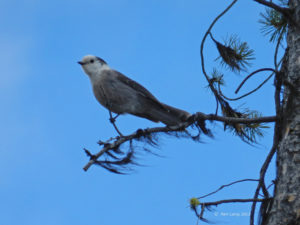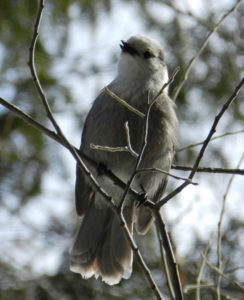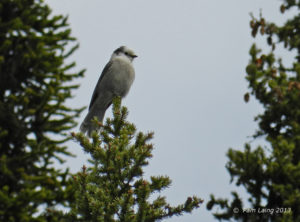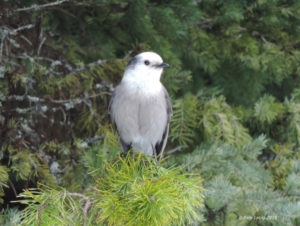Which Bird might I see today? – YEAR ROUND –
Canada’s National Bird

“Quiet, bold, impulsive and curious”. All of these have been used to describe the bird recently voted Canada’s pick for National Bird. Voting began in January 2015 and was conducted by Canadian Geographic. Tens of thousands of votes were cast and eventually, in November 2016, the result was made public. A bird that for 200 years was officially known as the Canada Jay until renamed Gray Jay in 1957 by the official North American bird naming body, the AOU (American Ornithological Union), had risen to the top and was our number one pick. Gray Jay or Canada Jay – this is OUR bird.
 Gray Jays are 11½“/~ 30 cm in size. They have pale grey soft-looking plumage, long tails and very short beaks. One field guide says a Gray Jay “resembles an oversized chickadee”. Newly fledged young birds in the west are very dark grey, almost black. Most Gray Jays move through the forest in small groups of three or four birds.
Gray Jays are 11½“/~ 30 cm in size. They have pale grey soft-looking plumage, long tails and very short beaks. One field guide says a Gray Jay “resembles an oversized chickadee”. Newly fledged young birds in the west are very dark grey, almost black. Most Gray Jays move through the forest in small groups of three or four birds.
Gray Jays are year-round residents of every province and territory. They do not migrate southwards but do sometimes move from upper elevations into lower during the winter. They prefer the boreal and mountain forests which blanket nearly 2/3 of our country, only a small percentage crossing into Alaska and the western mountains of the US. They have never been recorded outside of North America. Among the best places to see them locally are upper Beaver Lake Road or Oyama Lake Road.
 Gray Jays are amazingly hardy. They nest in February, when the forests are still thick with snow. They have even been recorded as incubating eggs in snowstorms and temperatures as low as -30C! Members of the corvid family, related to crows, ravens and the Blue Jay, they are among the most intelligent of all birds. Their brain to body ratio is almost the same as that of humans. They cache food, mainly insects or small fruits, in many hiding places throughout their territories and are amazingly adept at recalling exactly where.
Gray Jays are amazingly hardy. They nest in February, when the forests are still thick with snow. They have even been recorded as incubating eggs in snowstorms and temperatures as low as -30C! Members of the corvid family, related to crows, ravens and the Blue Jay, they are among the most intelligent of all birds. Their brain to body ratio is almost the same as that of humans. They cache food, mainly insects or small fruits, in many hiding places throughout their territories and are amazingly adept at recalling exactly where.
 Gray Jays have always held importance for Canada’s First Nations. In Cree they are called “Wisakedjak” which has been Anglicized to our common nickname for the species, Whiskey Jack. In Cree teachings the bird is often regarded as a ‘shape-shifter’, a benevolent trickster, teacher and messenger of the forest. To many western First Nations, the appearance of a Gray Jay in the morning is a good omen.
Gray Jays have always held importance for Canada’s First Nations. In Cree they are called “Wisakedjak” which has been Anglicized to our common nickname for the species, Whiskey Jack. In Cree teachings the bird is often regarded as a ‘shape-shifter’, a benevolent trickster, teacher and messenger of the forest. To many western First Nations, the appearance of a Gray Jay in the morning is a good omen.
As well as Whiskey Jack the Gray Jay has also been dubbed Camp Robber. Many of us have experienced their thieving presence at picnic tables in the woods. They are frequent visitors to lumber or mining camps and research stations, showing no fear of humans and often behaving in a very tame, curious and confiding manner, which is endearing.
As Canadian Geographic scientists and others have said, “We cannot think of a more Canadian bird.”
Pam Laing, Okanagan birder







Carl shearer
I have always been intrigued by the whiskey jack. Such an interesting bird, lots of fun to have them around the cabin nor campsite. A good choice
Pam
Yes, I think so too. Thanks for your comment. They are a companionable bird to have around.
Sue MacGregor
Very interesting and informative article. Thanks for sharing.
Once while staying in a fishing camp at Hefley Lake (near Kamloops), the hostess
had the Gray Jays eating out of her hand.
Fascinating birds!
We support the choice!
lakecountry
Nice to hear your comments, Sue. I know you are another ardent Okanagan birder.
Pam
Thanks, Sue. We once had to stop eating our picnic and retreat to the truck, as they were so determined to share our lunch. Then they marched up and down outside the windshield looking at us beggingly. This was in fall, and we reckon they had been accustomed to people feeding them during the summer. I love their soft cheery whistles too.
Pam
Mike
Have come across them before, definitely show no fear of humans, I had to take care not to step on one while is was working, must have been a youngling because very small, but he would follow me eat the bugs that I stirred up walking through the grass.